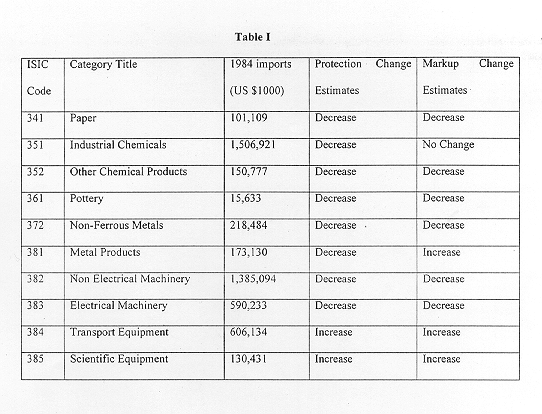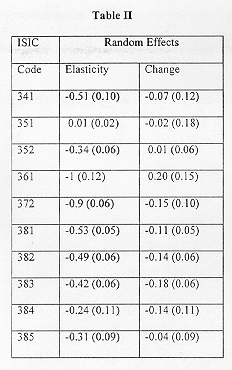
International Trade and Labor Markets: Evidence from Turkey
Sajjid Chinoy, Department of Economics, Stanford University,
Pravin
Krishna, Department of Economics, Brown University,
Devashish Mitra,*
Department of Economics, Florida International University, E-mail:
mitrad@fiu.edu
Abstract
In the recent debate over the impact of trade reform on factor markets, it has been theoretically argued that under imperfect competition trade liberalization will lead to an increase in labor demand elasticities - thus placing labor markets under increased pressure. Using Turkish plant level data spanning the course of a dramatic trade liberalization, this idea is tested. (JEL F02, F12, F13, F15)
1. Introduction
The link between trade and labor markets has received considerable attention by both trade and labor economists. However, they have mainly focussed on the impact of openness on wages and wage inequality in perfectly competitive settings (Stolper Samuelson effect). Jagdish Bhagwati and Vivek H. Dehejia (1994), Robert Z. Lawrence and Matthew J. Slaughter (1993), Jeffery D. Sachs and Howard J. Shatz (1994) and Richard B. Freeman and Lawrence F. Katz (1994) are major contributions to this literature.
Recent contributions by Matthew J. Slaughter (1997) and Dani Rodrik (1997) have taken a different direction. These papers study the tendency of greater openness to increase the firm level elasticity of labor demand. The argument here is based on the Hicks' fundamental law of factor demand which states that an increase in the elasticity of output demand leads to an increase in the elasticity of input demand. Under imperfect competition, since the former rises with trade liberalization, the latter rises as well.
Rodrik (1997) argues that as a consequence of trade liberalization labor markets may come under "greater pressure," since rising labor demand elasticities shift the wage and employment incidence of non-wage labor costs towards labor away from employers, result in more volatile responses of wages and employment to any exogenous shocks to labor demand and take the bargaining power over rent sharing away from labor.
We study this link between trade openness and factor demand elasticities using Turkish manufacturing census data. As Table I (source: James Levinsohn,1993) indicates, protection declined in Turkey in a large number of industries as a result of a substantial liberalization of trade policy that was undertaken in 1984, thereby providing a unique opportunity to test the above mentioned link.
2. Methodology
Assuming monopolistic competition, a constant elasticity demand function and a Cobb-Douglas production function in labor, capital, materials and fuel, we can derive the labor demand function as
log Lijt = c0 + c1 log(w/Pj ) + c2 log(r/Pj ) + c3 log(m/Pj ) + c4 log(f/Pj ) + eijt
where Lijt represents labor demand by firm i in industry j in time t, while w, r, m and f represent wages, rental, material prices and fuel prices respectively at the firm level and Pj is the average price of the product produced by industry j. It can be easily verified that an increase in product demand elasticity leads to an increase in the own price elasticity of demand for labor. The above equation will be our basic estimating equation. To capture the effect of change in trade policy on elasticities, we also include intercept and interactive trade reform dummies which take the value of one for the post liberalization period.
3. Data
We use detailed plant level input and output data on all firms in Istanbul from the Turkish manufacturing census. This data set has earlier been used by Levinsohn (1993) in studying the impact of trade liberalization on market discipline. We measure production labor as the sum of male and female high level and medium level technical personnel, male and female foremen and male and female workers. Nominal firm level wage is production workers' payroll divided by the number of production workers. We use three digit industry specific raw materials input price indices and fuel prices. Economy wide annual interest rate data are used for rental costs.
4. Estimation Issues
The first issue here is the simultaneity problem since both demand and supply depend on the wage. Our assumption here however is that while labor supplies facing each firm are perfectly elastic, at the industry level labor may be inelastically supplied. The suitability of this identifying assumption rests on the degree of disaggregation of the data. Given our plant level data, the simultaneity problem is not a major one.
The second is the issue of timing and lagged responses. However, the literature indicates that much of the adjustment in firm labor demand takes place within six months to a year. Our use of annual data mitigates this concern.
Aggregate demand shocks can increase wages and employment at the same time. There fore, biased elasticity estimates could be obtained due to a correlation between the error term and the independent variables. Our interest, however, is in the estimate of changes in elasticities due to the trade reform. Monte Carlo simulations do not report any bias that attenuates the estimate of the change in elasticity to zero, even though the elasticity estimates per se could be biased.
5. Results
Our estimation equation was estimated under both fixed and random effects specifications. The Hausman test statistic suggested that the random effects model was more appropriate than the fixed effects and therefore our presentation and discussion of the regression results focuses on the random effects model. As can be seen from Table II, our results indicate that the Turkish trade reforms did not result in significant changes in the elasticities of labor demand. Our estimates of changes in elasticities for most of the industries, while negative, are insignificant. This was true both for industries in which Levinsohn estimated markups to have risen as well as in those in which he estimated a fall in markups (See Table I).
6. Conclusions
Using plant level data over a period spanning major trade reforms in Turkey, in the vast majority of the industries considered in this paper, we are unable to reject the hypothesis of no relationship between greater trade openness and labor demand elasticities as suggested by the theory.
* We are grateful to Jagdish Bhagwati, Anjini Kochar, Anne Krueger, Julie Schaffner and especially our discussant, Hassan Arvin-Rad for very helpful comments and Jim Levinsohn and Jim Tybout for assistance in getting the data together.
References
Bhagwati, Jagdish and Dehejia, Vivek H. "Freer Trade and Wages of the Unskilled - Is Marx Striking Again?," in J. Bhagwati and M. H. Kosters, eds., Trade and Wages: Levelling Wages Down?, 1994, Washington, DC: AEI Press, pp. 36-75.
Freeman, Richard B. and Katz, Lawrence F. "Rising Wage Inequality: The United States vs Other Industrial Countries," NBER Research Project Report, New York: Russell Sage Foundation, 1994, pp. 29-62.
Lawrence, Robert Z. and Slaughter, Matthew J. "International Trade and American Wages in the 1980s: Gaint Sucking Sound or Small Hiccup." Brookings Papers on Economic Activity, Microeconomics 1993, 0(0), pp. 161-210.
Levinsohn, James. "Testing the Imports-as-Market-Discipline Hypothesis," Journal of International Economics, August 1993, 35(1/2), pp. 1-22.
Rodrik, Dani. Has Globalization Gone Too Far?. Washington DC: Institute for International Economics, 1997.
Sachs, Jeffery D. and Shatz, Howard J. "Trade and Jobs in US Manufacturing." Brookings Papers on Economic Activity, Microeconomics 1994, 0(1), pp. 1-69.
Slaughter, Matthew J. "International Trade and Labor Demand Elasticities," NBER Working Paper Number 6282, 1997.


Back to Volume 1
Back to Topics in Middle Eastern
and North African Economies Journal Home Page